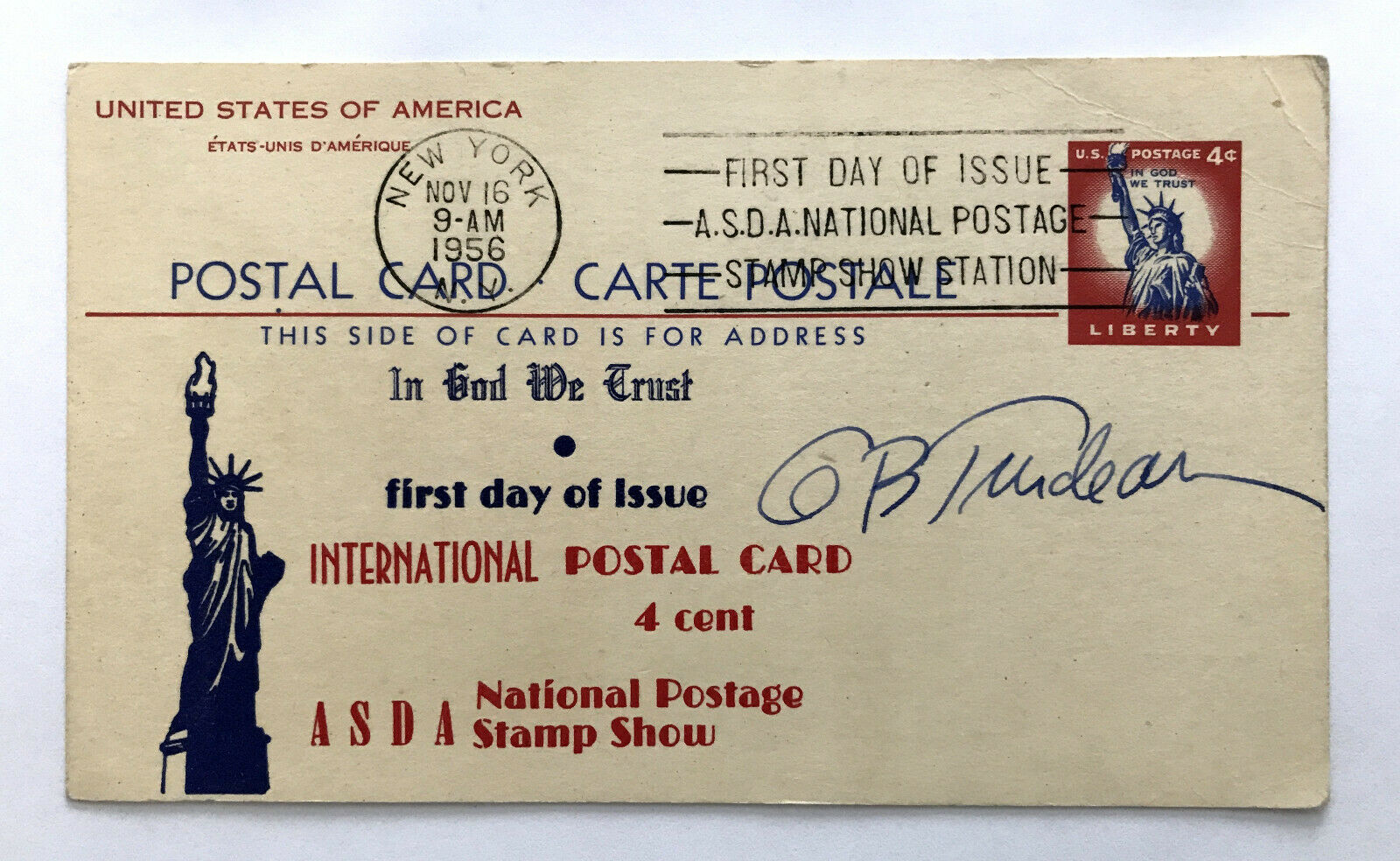-40%
CARTOONIST COMIC STRIP DOONESBURY GARRY TRUDEAU AUTOGRAPH SIGNED FDC POSTAL CARD
$ 5.27
- Description
- Size Guide
Description
GARRY B. TRUDEAU(b. 1948)
AMERICAN
PULITZER PRIZE-WINNING EDITORIAL
CARTOONIST FOR THE POPULAR SYNDICATED COMIC STRIP, “
DOONESBURY
”
&
PRESIDENT OF THE NATIONAL CARTOONISTS SOCIETY (NCS) 2007-2011.
Jeff Keane inherited the popular comic strip Family Circus from his father Bil Keane, who died in 2011.
Jeff was the inspiration and model for the cartoon character “Jeffy.”
<<>>
::
<<>>
HERE’S A SIGNED FIRST DAY OF ISSUE POSTAL CARD FOR THE “
LIBERTY
” and “
IN GOD WE TRUST
” 4 c US POSTAL CARD and STAMP ISSUED ON NOV. 16, 1956.
THIS PARTICULAR POSTAL CARD WAS ISSUED AT THE AMERICAN STAMP DEALERS ASSOCIATION (ASDA) NATIONAL POSTAGE STAMP SHOW.
The card document measures 5½” x 3¼” and is in VERY FINE CONDITION.
<>
(
The first
Doonesbury
cartoon, from October 26, 1970
)
Garretson Beekman Trudeau
(born July 21, 1948) is a Pulitzer Prize winning American
cartoonist
, best known for creating the
Doonesbury
comic strip. Trudeau is also the creator and executive producer of the
Amazon Studios
political comedy series
Alpha House
.
<>
TRUDEAU’S USE OF REAL-LIFE POLITICIANS AS CHARACTERS
While
Doonesbury
frequently features real-life U.S. politicians, they are rarely depicted with their real faces. Originally, strips featuring the President of the United States would show an external view of the
White House
, with dialogue emerging from inside. During the
Gerald Ford
administration, characters would be shown speaking to Ford at press conferences, and fictional dialogue supposedly spoken by Ford would be written as coming "off-panel". Similarly, while having several characters as students in a class taught by
Henry Kissinger
, the dialogue made up for Kissinger would also come from "off-panel" (although Kissinger had earlier appeared as a character with his face shown in a 1972 series of strips in which he met Mark Slackmeyer while the latter was on a trip to Washington). Sometimes hands, or in rare cases, the back of heads would also be seen.
Later, personal symbols reflecting some aspect of their character came into use. For example, during the 1980s, character Ron Headrest served as a
doppelgänger
for
Ronald Reagan
and was depicted as a computer-generated artificial-intelligence, an image based on the television character
Max Headroom
. Members of the
Bush family
have been depicted as invisible. During his term as Vice President,
George H. W. Bush
was first depicted as completely invisible, his words emanating from a little "voice box" in the air. (In one strip, published March 20, 1988, the vice president almost materialized, but only made it to an outline before reverting to invisibility.
)
George W. Bush
was symbolized by a
Stetson
hat atop the same invisible point, because he was
Governor of Texas
prior to his presidency (Trudeau accused him of being "all hat and no cattle", reiterating the characterization of Bush by columnist
Molly Ivins
). The point became a giant
asterisk
(a la
Roger Maris
) following the
2000 presidential elections
and the controversy over vote-counting. Later, President Bush's hat was changed to a
Roman military helmet
(again, atop an asterisk) representing imperialism. Towards the end of his first term, the helmet became battered, with the gilt work starting to come off and with clumps of bristles missing from the top. By late 2008, the helmet had been dented almost beyond recognition. No symbol for
Barack Obama
has appeared in the strip; the May 30, 2009, strip had Obama and an aide wondering what the reason for this might be (off panel).
Other symbols include a
waffle
for
Bill Clinton
(chosen by popular vote—the other possibility had been a
flipping coin
), an unexploded (but sometimes lit) bomb for
Newt Gingrich
, a feather for
Dan Quayle
, and a giant groping hand for
Arnold Schwarzenegger
(who is addressed by other characters as "Herr Gröpenfuhrer", a reference to accusations of sexual assault against Schwarzenegger). Many less well-known politicians have also been represented as icons over the years, like a
swastika
for
David Duke
, but only for the purposes of a gag strip or two. Trudeau has made his use of icons something of an
in joke
to readers, where the first appearance of a new one is often a
punchline
in itself.
The long career of the series and continual use of real-life political figures, analysts note, have led to some uncanny cases of the cartoon foreshadowing a national shift in the politicians' political fortunes. Tina Gianoulis in
St. James Encyclopedia of Popular Culture
observes that "In 1971, well before the
conservative Reagan years
, a forward-looking BD called Ronald Reagan his 'hero.' In 1984, almost ten years before Congressman Newt Gingrich became
Speaker of the House
, another character worried that he would 'wake up someday in a country run by
Newt Gingrich
.'" In 1999, Donald Trump was depicted as a presidential candidate. In its 2003 series "
John Kerry
: A Candidate in the Making" on the
2004 presidential race
,
The Boston Globe
reprinted and discussed 1971
Doonesbury
cartoons of
the young Kerry's Vietnam War protest speeches
.
I am a proud member of the Universal Autograph Collectors Club (UACC), The Ephemera Society of America, the Manuscript Society & the American Political Items Collectors (APIC) (member name: John Lissandrello). I subscribe to each organizations' code of ethics and authenticity is guaranteed. ~Providing quality service & historical memorabilia online for over 20 years.~
WE ONLY SELL GENUINE ITEMS, i.e., NO REPRODUCTIONS, FAKES OR COPIES
Collectibles > Autographs > Celebrities
Collectibles > Comics > Newspaper Comics











